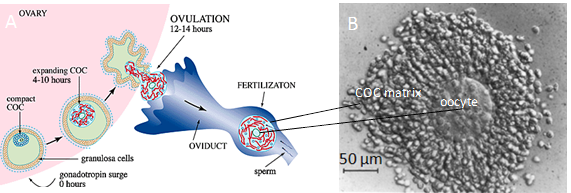An illustrative example of a cross-linked PCM is the cumulus cell-oocyte complex (COC) matrix. This extended viscoelastic coat forms around oocytes just a few hours before ovulation and surrounds the oocyte on its journey towards fertilization in the oviduct. Before hormonal stimulation, the ovulating follicle represents a cavity filled with follicular fluid, where the wall of the follicle is formed by several layers of granulosa cells attached to the basement membrane. The oocyte is attached to the follicle wall and surrounded by 1000 closely packed cumulus cells, such close packing is needed to maintain communication between the cumulus cells and oocyteAlbert et al., 2008. At the time of hormonal stimulation, there is very thin PCM around cumulus cells (Figure 3), but during the following hours a progressive accumulation of HA takes place leading to COC matrix expansion. Shortly before ovulation the COC matrix reaches its maximal volume ( 20 times its initial state) Salustri et al., 1989. While HA is the predominant stuctural component of the COC matrix, matrix expansion is also driven by the ingress of water because of the polyanionic nature of HA..

In order to keep the expanded COC matrix cohesive, i.e. to stabilize its structure, HA chains need to be cross-linked. Treatment with protease demonstrated that the matrix can be completely dissolved, revealing a fundamental role of proteins in the stabilization of the COC matrix Cherr et al., 1990. Several proteins were identified to participate in matrix organization, (i) a group of the proteins which bind HA directly : TSG-6 Carrette et al., 2001Mukhopadhyay et al., 2001Ochsner et al., 2003, versican Russell et al., 2003, heavy chains (HC) of IαI Zhuo et al., 2001and cartilage link protein Kobayashi et al., 1999, and (ii) proteins that does not possess a HA-binding motif : PTX3 Salustri et al., 2004Scarchilli et al., 2007, fibronectin, tenascin and laminin Familiari et al., 2006.
The typical way to demonstrate the structural role of proteins in the assembly of the COC matrix is to disrupt their synthesis. In this way, it was demonstrated that loss of either TSG-6 or IαI expression perturbed matrix expansion and ovulation, although HA production was not affected. This led to a drastic decrease in the rate of in vivo fertilization Russell et al., 2003Sato et al., 2001Fulop et al., 2003. Notably, COC matrix expansion could be completely blocked by addition of short HA oligosaccharides that compete for TSG-6 Hess et al., 1999, suggesting that TSG-6 is a key player in matrix stabilization.
Furthermore the literature demonstrates that COC matrix expansion and successful ovulation depend on the interaction of IαI, in addition to TSG-6, with HA Carrette et al., 2001Ochsner et al., 2003Fulop et al., 2003. Moreover, PTX3 deficient mice could achieve cumulus expansion in vivo, but failed to fertilize because of the rapid disassembly and loss of the COC matrix during release from the follicle Salustri et al., 2004Varani et al., 2002. Thus, PTX3 can additionally stabilize the COC matrix and support its retention around the oocyte. The bottle-shaped proteoglycan versican, closely related to aggrecan of cartilage tissue, was also suggested to be involved in matrix assembly Rodgers & Irving-Rodgers. Whether it is critical for COC matrix expansion has not been confirmed, because removal of versican is lethal making direct knockout studies impossible Russell et al., 2003. However, there is no indirect evidence that cross-linking by versican might take place, but rapid cleavage of the versican in the COC matrix is required for successful ovulation Brown et al.,.
It is likely that COC matrix expansion is required for successful ovulation. Together with the thinning of the follicle wall by proteolytic degradation, the expansion of the COC matrix could exhibit an additional pressure on the wall promoting follicle rupture Rodgers & Irving-Rodgers. A cohesive and thick COC matrix is also important for the capture of the oocyte by the oviduct and subsequent transport through the oviduct. In particular, there is a selective adhesion between the cilia of the oviduct epithelium and the COC matrix Lam et al.,2000. Only an oocyte endowed with a proper matrix can efficiently pass through the oviductal lumen Lam et al., 2000Talbot et al., 2003. In addition, the COC matrix may present a selective barrier that screens for sperm with high fertility potential Hong et al., 2004. PTX3 was shown to bind sperm cells and attract sperm to the COC in the oviduct Salustri et al., 2004. Another protein of unknown identity, yet with a size that would be consistent with versican, was shown to promote acrosomal reaction – the release of hyaluronidases by sperm Tesaril et al., 1988Drahorad et al., 1991. The degree of cumulus expansion has been found to be indicative of high oocyte quality and has been used as a criterion for selection of oocytes for in vitro fertilization during many years Ball et al., 1983. All this in vivo data provide compelling evidence that the correct self-assembly of HA and proteins into the COC matrix is functionally important
